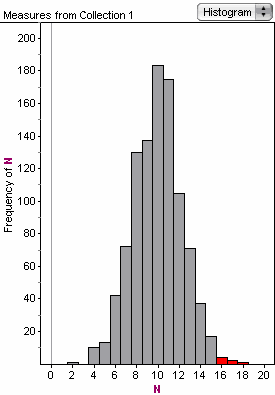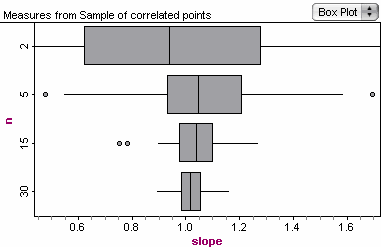Yikes. Another couple months. And a lot has happened: I experienced senioritis firsthand, our house has been rendered uninhabitable by a kitchen remodel (so we’re living out of suitcases in friends’ spare rooms), and my first year of actually teaching stats has drawn to a close.
It is time to reflect.
My tendency is to flagellate myself about how badly I suck, so (as suggested by Karen E, my brilliant and now former assistant head of school, we’ll miss you, Karen!) let me take a deep breath and report first on what seemed to work. Plenty of time for self-flagellation later.
Resampling, Randomization, Simulation, and Fathom
The big overarching idea I started with—to approach inferential statistics through resampling à la George Cobb—worked for me and for at least some students. It is not obvious that you can make an entire course for these students with randomization as the background. I mean, doing this is mapping an entirely new path through the material. Is it a good path? I’m not certain, but I still basically believe it is.
To be sure, few of my students got to the point where they automatically chose the right technique at every turn. But they did the right thing a lot, and most important for me, I never had to leave them in some kind of mathematical dust where they made some calculation. For example, (and I may be wrongly proud of this) we got through an entire year of statistics without introducing the Normal distribution. This may seem so heretical to other teachers, it deserves a post of its own. Later. The point here is that no student ever was in a position of calculating NormalCDF-of-something and not understanding what it really meant.
Did they perform randomization tasks and not really understand? Sure. But when they did, they did so “closer to their data,” so they had a better chance to fix that non-understanding. They didn’t rely (for example) on the Central Limit Theorem—which, let’s face it, is a black box—to give them their results.
Fathom and Technology
Fathom was a huge suggess throughout. It was great to be able to get them all the software and assign homework in Fathom. They enjoyed it, and really became quite adept at using the tool.
One big question was whether they would be able to use the “measures” mechanisms for creating their own simulations. Basically, they can. It’s a big set of skills, so not all of them can do everything we covered, but in general, they understand how to use the software to implement randomization and simulation techniques. This goes hand in glove with actually understanding what these procedures accomplish.
We also became more and more paper-free as the year went on, setting and turning in more and more assignments as pdfs. The “assignment drop box” wasn’t perfect, but it worked well enough.
Starting SBG
I decided to try standards-based grading, at least some local version of it, in this first year. On reflection, that was pretty gutsy, but why wait? And it worked pretty well. Most importantly, students overwhelmingly approved; the overall comment was basically, “I like knowing what’s expected.” Furthermore—and this may be a function of who the kids were more than anything else, bit I’ll take it—there was hardly any point-grubbing.
It is also satisfying to look over my list of 30-ish standards and see that
- They largely (but not completely) span what I care about.
- They set standards for different types of mastery, ranging from understanding concepts to using the technology to putting together coherent projects.
They need editing, and I need to reflect more about how they interact, but they are a really good start.
Flipping and Video
At the semester break, I decided to take a stab at “Flipping the Classroom.” This was a big win, at least where I used it most—in giving students exposition about probability.
There is a lot that can go wrong with videos as instruction (the Khan brouhaha is a good example; see this Frank Noschese post for a good summary of one view) and I want to explore this more. But the basic idea really works, and the students recognized it: if it’s something you would lecture about, putting it on the video has two big plusses:
- They can stop and rewind if they don’t get it
- You can do it over til you get it the way you want. No more going back and saying, “when I said x it wasn’t quite right…”
My big worry is that if I assign videos as homework, hoping to clarify and move on in class, that the lazy student may watch, but will blow off thinking, assuming that they can get me to cover it again. I need to figure out a non-punitive way around that problem; or maybe it’s not so bad simply to be able to use class time for the first repetition…
Some Cool Ideas
Besides these esssentially structural things, I had some frankly terrific ideas during the year. Some I have mentioned before, but let me list just four, just as snippets to remind me what they were; later if I get to it I’ll elaborate:
- Using sand timers and stopwatches to explore variability.
- Going to the nearby freeway overpass to sample cars.
- Using the school’s library catalog to do random sampling.
- Going to the shop to make dice that were not cubes.
There were other curricular successes such as using old material from Data in Depth—particularly the Sonatas—for work during the first semester.
Wonderful Kids
I can’t say enough about how much I appreciate the students. Again, I could do better at helping create a really positive class culture, but they did pretty damned well on their own. They got along well, took care of each other, exchanged good-natured barbs, were good group members and contributors.
Even the most checked-out seniors, already accepted into college and having reached escape velocity: they may not have worked very hard outside of class, and assignments may have slipped, but in class they were engaged and still learning. And some juniors did strong, strong work that will make writing college recs easy next year.
And I got a couple of those letters—teachers, you know the ones I mean—that make it worth the effort.
So all in all, a good year. Much to improve, yes. But it’s worth savoring what went right.








